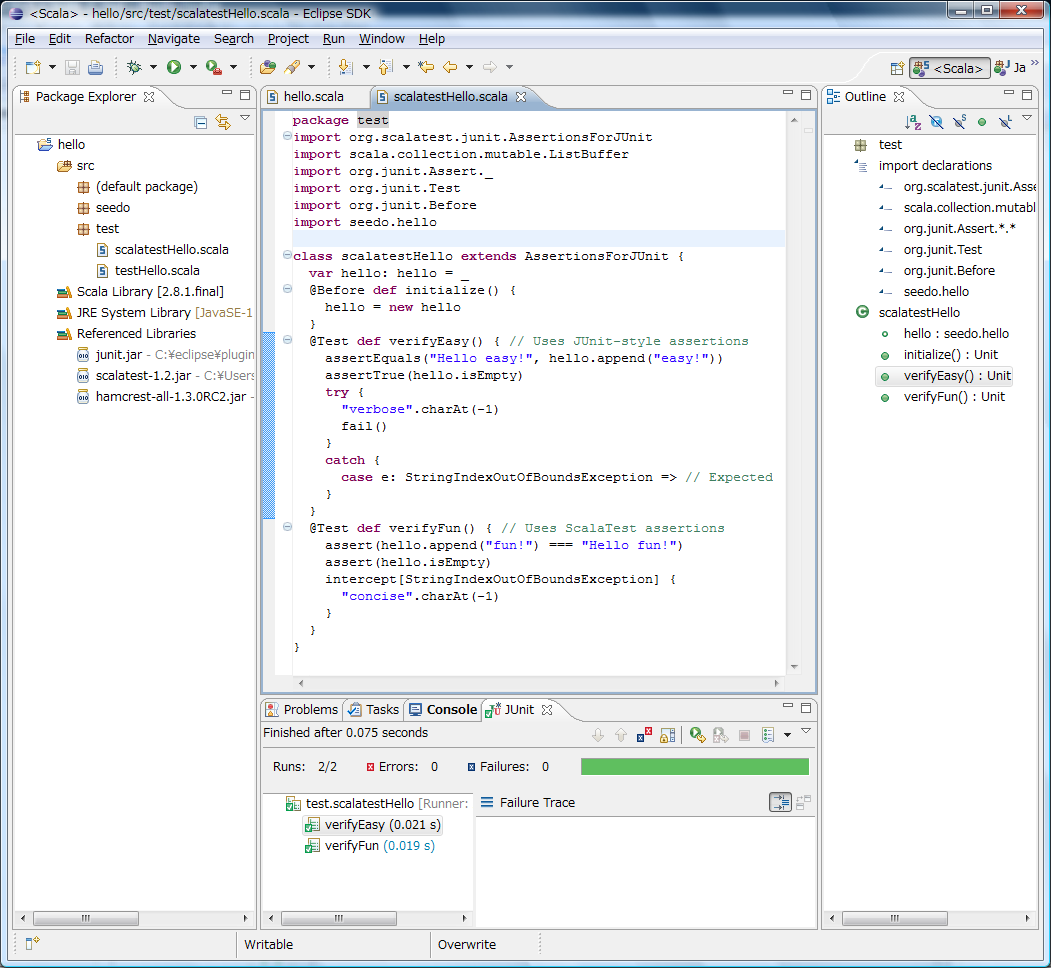Scala Test
Scalaでテストというと、Scala Test でしょう。いろいろなサイトで使い方が紹介されています。
Scala Testのサイトは、http://www.scalatest.org/です。
Scala Testサイトにある、Getting started with JUnit 4 and ScalaTestを参考にしてコードを書いてみます。
Scala Testを使ってテストを試すために、先ほどのhelloクラスを拡張します。
package seedo
import java.util.Date
import java.text._
class hello {
val me = "Hello"
def now : Date = {
new Date
}
def append(str:String) : String = {
me + " " + str
}
def isEmpty : Boolean = true
}
Scala Testで書いたテストコードです。
アサーションの書き方には、JUnitスタイルと、Scala Testスタイルの2種あります。
どちらを使うかは好みです。
package test
import org.scalatest.junit.AssertionsForJUnit
import org.junit.Assert._
import org.junit.Test
import org.junit.Before
import seedo.hello
class scalatestHello extends AssertionsForJUnit {
var hello: hello = _
@Before def initialize() {
hello = new hello
}
@Test def verifyEasy() { // Uses JUnit-style assertions
assertEquals("Hello easy!", hello.append("easy!"))
assertTrue(hello.isEmpty)
try {
"verbose".charAt(-1)
fail()
}
catch {
case e: StringIndexOutOfBoundsException => // Expected
}
}
@Test def verifyFun() { // Uses ScalaTest assertions
assert(hello.append("fun!") === "Hello fun!")
assert(hello.isEmpty)
intercept[StringIndexOutOfBoundsException] {
"concise".charAt(-1)
}
}
}
Scalaスタイル
Scalaでプログラム書くんだから、「スタイルはScalaスタイル」という人は、JUnitSuiteというクラスを使いましょう。
これを使うには、テストクラスは JUnitSuite を継承させます。
package test
import org.scalatest.junit.JUnitSuite
import org.junit.Assert._
import org.junit.Test
import org.junit.Before
import seedo.hello
class scalatestHello2 extends JUnitSuite {
var hello: hello = _
@Before def initialize() {
hello = new hello
}
@Test def verifyEasy() { // Uses JUnit-style assertions
assertEquals("Hello easy!", hello.append("easy!"))
assertTrue(hello.isEmpty)
try {
"verbose".charAt(-1)
fail()
}
catch {
case e: StringIndexOutOfBoundsException => // Expected
}
}
@Test def verifyFun() { // Uses ScalaTest assertions
assert(hello.append("fun!") === "Hello fun!")
assert(hello.isEmpty)
intercept[StringIndexOutOfBoundsException] {
"concise".charAt(-1)
}
}
}
さらに、「===」なんてという人は、「~じゃないと」という雰囲気で書くことも。
ShouldMatchersForJUnitクラスをimportして使います。
~should be ~ というように書きます。
hello.append("fun!") should be ("Hello fun!")
package test
import org.scalatest.junit.JUnitSuite
import org.scalatest.junit.ShouldMatchersForJUnit
import org.junit.Test
import org.junit.Before
import seedo.hello
class scalatestHello3 extends JUnitSuite with ShouldMatchersForJUnit{
var hello: hello = _
@Before def initialize() {
hello = new hello
}
@Test def verifyEasy() { // Uses JUnit-style assertions
assert(hello.append("easy!") === "Hello easy!")
assert(hello.isEmpty)
try {
"verbose".charAt(-1)
fail()
}
catch {
case e: StringIndexOutOfBoundsException => // Expected
}
}
@Test def verifyFun() { // Uses ScalaTest assertions
hello.append("fun!") should be ("Hello fun!")
assert(hello.isEmpty)
intercept[StringIndexOutOfBoundsException] {
"concise".charAt(-1)
}
}
}
このスタイルの雰囲気は西洋風でいいですね。

コメントを残す
コメントを投稿するにはログインしてください。